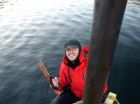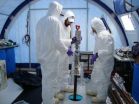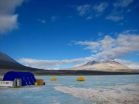(Press-News.org) For researchers who study Earth's past environment, disentangling the effects of climate change from those related to human activities is a major challenge, but now University of Massachusetts Amherst geoscientists have used a biomarker from human feces in a completely new way to establish the first human presence, the arrival of grazing animals and human population dynamics in a landscape.
Doctoral student Robert D'Anjou and his advisor Raymond Bradley, director of the Climate System Research Center at UMass Amherst, with UMass colleagues Nick Balascio and David Finkelstein, describe their findings in the current online edition of Proceedings of the National Academy of Sciences.
"We are really excited about how well this method worked," D'Anjou says. "Without even knowing it, early settlers were recording their history for us, and in the most unlikely of ways, in their poop. The prehistoric settlers and their livestock pooped and their feces washed into the lake, which over time left a record of trace amounts of specific molecules that are only produced in the intestines of higher mammals. When you find these molecules at certain concentrations and in specific ratios, it provides an unmistakable indicator that people were living in the area."
Bradley adds, "This approach opens the door to other studies, where the presence of humans is uncertain; we believe it has great potential for much wider applications in archaeology."
D'Anjou carried out the work just north of the Arctic Circle, at Lake Liland in the Lofoten Islands in northern Norway, where humans were thought to have lived in prehistoric settlements from the early Iron Age through the Viking period. They extracted two sediment cores from the lake bottom and used radiocarbon measurements and the presence of volcanic ash from Iceland to establish their chronology. The sediments provided a continuous record extending back roughly 7,000 years.
Paleoclimatologists have long used markers in lakebed sediments, such as charcoal from humans' fires and pollen from cultivated plants, as a natural archive of environmental changes to estimate when humans first began having an impact. But these indirect indicators must be used with care when reconstructing the history of a place because it's not always clear that they indicate human activity in the same area.
By contrast, the presence of a molecular biomarker directly linked to humans, one transmitted through their bowel movements, offers "a strong human signal," as the authors put it, one that can be dated with "excellent chronological control." D'Anjou and colleagues extracted the compound coprostanol, a molecular marker formed from the digestion of cholesterol in the human gut, from the sediment, plus other sterols characteristic of other mammals to estimate the presence of sheep and cattle. From these, they were able to produce a long-term record of the presence and relative population size of humans extending back over thousands of years at the site.
In addition, the geoscientists used two other molecular markers to reconstruct the vegetation history: relative length of carbon molecules found in leaf waxes (different in forest and grassland), and pyrolytic polycyclic aromatic hydrocarbons (PAH) as evidence of fire in the Lake Liland area. They say that taken together, the sediment cores, vegetation changes and fire records clearly define a pre-settlement period with no detectable human activity in the lake's water catchment area from about 7,300 to 2,250 years ago.
At that point, however, changes in the background state appear in the record, marking an "abrupt shift" to significantly increased levels of pyrolytic PAH first, followed by increased human fecal material. This likely indicates that as people moved in, they first cleared the land by burning before establishing a permanent settlement, the researchers say. "This interpretation is bolstered," they add, by the leaf wax record that shows a "marked transition to a more grassland-dominated landscape beginning at this time."
After the initial influx of people to the region, D'Anjou and colleagues say the record shows a lull in human activity from about 2,040 to 1,900 years ago, reflected in all markers. After this, the human and livestock populations steadily increased to a local maximum around the year 500, based on the fecal record, then fell again to a second minimum around the year 850.
The climate scientists note a further decline in human activity and population to another minimum at about AD 1750 that coincided with the highest relative grassland cover for the entire 7,300-year history. Findings related to human activity over the past 7,300 years in northern Norway correlate well with other climate reconstructions, in particular summer temperature patterns indicating poor vs. fruitful growing seasons. This shows that the early settlers were vulnerable to small changes in summer temperature at this far northern location.
Overall, the authors say, the new fecal markers are likely to prove valuable in many other places, to distinguish natural from human factors that influenced the environment in the past.
INFORMATION:
This work was funded by the U.S. National Oceanographic and Atmospheric Administration.
Using biomarkers from prehistoric human feces to track settlement and agriculture
2012-11-27
ELSE PRESS RELEASES FROM THIS DATE:
This week's forecast: Sunny with a 40 percent chance of flu
2012-11-27
NEW YORK (November 26, 2012)—Scientists have developed a system to predict the timing and severity of seasonal influenza outbreaks that could one day help health officials and the general public better prepare for them. The system adapts techniques used in modern weather prediction to turn real-time, Web-based estimates of influenza infection into local forecasts of seasonal flu.
Results appear online in the Proceedings of the National Academy of Sciences.
Year to year, and region to region, there is huge variability in the peak of flu season, which, in temperate areas ...
New hope for setback-dogged cancer treatment
2012-11-27
Several drugs companies have ineffectively tried to produce antibodies that bind to the IGF-1 receptor on the cell surface, which has a critical part to play in the development of cancer. Scientists at Karolinska Institutet in Sweden have now ascertained how these antibodies work, and can explain why only some cancer patients are helped by IGF-1 blockers during clinical tests. The researchers also present a means by which drugs of this kind could help more cancer patients.
Every cell contains thousands of tiny receptors that help it communicate with other cells. These ...
Ancient microbes found living beneath the icy surface of Antarctic lake
2012-11-27
RENO – This week a pioneering study published in the Proceedings of the National Academy of Sciences (PNAS) and co-authored by Dr. Alison Murray and Dr. Christian Fritsen of Nevada's Desert Research Institute (DRI) reveals, for the first time, a viable community of bacteria that survives and ekes out a living in a dark, salty and subfreezing environment beneath nearly 20 meters of ice in one of Antarctica's most isolated lakes.
Lake Vida, the largest of several unique lakes found in the McMurdo Dry Valleys, contains no oxygen, is mostly frozen and possesses the highest ...
Possible new treatment for Ewing sarcoma
2012-11-27
SALT LAKE CITY— Discovery of a new drug with high potential to treat Ewing sarcoma, an often deadly cancer of children and young adults, and the previously unknown mechanism behind it, come hand-in-hand in a new study by researchers from Huntsman Cancer Institute (HCI) at the University of Utah. The report appears in today's online issue of the journal Oncogene.
"Ewing sarcoma is almost always caused by a cancer-causing protein called EWS/FLI," said Stephen Lessnick, M.D., Ph.D., director of HCI's Center for Children's Cancer Research, professor in the Department of ...
Bioengineered marine algae expands environments where biofuels can be produced
2012-11-27
Biologists at UC San Diego have demonstrated for the first time that marine algae can be just as capable as fresh water algae in producing biofuels.
The scientists genetically engineered marine algae to produce five different kinds of industrially important enzymes and say the same process they used could be employed to enhance the yield of petroleum-like compounds from these salt water algae. Their achievement is detailed in a paper published online in the current issue of the scientific journal Algal Research.
The ability to genetically transform marine algae into ...
Students at cooperative schools are more engaged
2012-11-27
This press release is available in Spanish.
Student engagement is not independent of the type of school attended.Nor is it independent of the organisational development of the school.The school's organisational style affects the work of its teaching staff, which, in turn, has repercussions on the performance and engagement of their students.As IkerRos, the UPV/EHU researcher, has been able to verify in his PhD thesis, these factors vary when comparing public schools, subsidised schools and co-operative schools, the latter being the ones that fare best.
"The study of ...
Dramatic rise in autism prevalence parallels research explosion
2012-11-27
(NEW YORK, N.Y., November 26, 2012) – Autism Speaks Chief Science Officer Geraldine Dawson, Ph.D. describes how the dramatic progress in autism research has paralleled increased recognition of autism's prevalence and financial impact in the December issue of the Archives of General Psychiatry published on line today. "This issue of the journal features three articles on autism," she writes in her editorial. "A decade ago, the journal published about the same number of autism articles per year."
Dr. Dawson also notes that, while the funding for autism research has dramatically ...
University of Maryland School of Medicine, NIH study pinpoints brain area's role in learning
2012-11-27
An area of the brain called the orbitofrontal cortex is responsible for decisions made on the spur of the moment, but not those made based on prior experience or habit, according to a new basic science study from substance abuse researchers at the University of Maryland School of Medicine and the National Institute on Drug Abuse (NIDA). Scientists had previously believed that the area of the brain was responsible for both types of behavior and decision-making. The distinction is critical to understanding the neurobiology of decision-making, particularly with regard to substance ...
Algae Biomass Organization hails new UCSD study showing saltwater algae viable for biofuels
2012-11-27
SAN DIEGO, Calif. (November 26, 2012) The Algae Biomass Organization, the trade association for the U.S. algae industry today hailed the findings of a University of California at San Diego study that concludes, for the first time, that marine (saltwater) algae can be just as capable as freshwater algae in producing biofuels. The research is documented in a peer-reviewed paper published online in the current issue of the scientific journal Algal Research.
"What this means is that you can use ocean water to grow the algae that will be used to produce biofuels. And once ...
Hearty organisms discovered in bitter-cold Antarctic brine
2012-11-27
EAST LANSING, Mich. — Where there's water there's life – even in brine beneath 60 feet of Antarctic ice, in permanent darkness and subzero temperatures.
While Lake Vida, located in the northernmost of the McMurdo Dry Valleys of East Antarctica, will never be a vacation destination, it is home to some newly discovered hearty microbes. In the current issue of the Proceedings of the National Academy of Sciences, Nathaniel Ostrom, Michigan State University zoologist, has co-authored "Microbial Life at -13ºC in the Brine of an Ice-Sealed Antarctic Lake."
Ostrom was part ...




